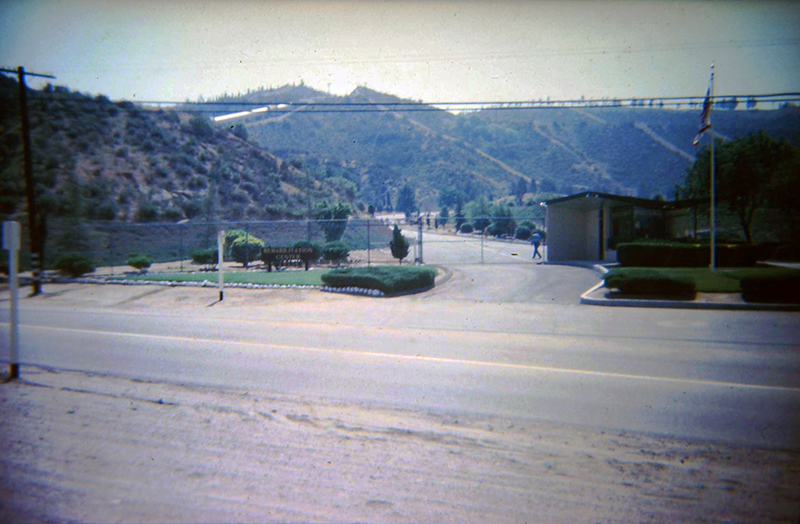L.A. City's Saugus Rehabilitation Center (Drunk Farm)
Saugus, California

Click image to enlarge
| Download original image
Entrance to the City of Los Angeles' Saugus Rehabilitation Center on Bouquet Canyon Road, circa 1964. L.A. City's aqueduct pipeline is visible on the hillside at left.
About the Saugus Rehabilitation Center (Drunk Farm). The Saugus Rehabilitation Center, aka Saugus Drunk Farm, on Bouquet Canyon Road — today's Santa Clarita Central Park and Rio Vista Water Treatment Facility — was a City of Los Angeles detention facility in the 1950s and 1960s when L.A. still operated its own court and jail systems. The 1849 California Constitution empowered the Legislature to create various types of "inferior" courts, as they were called (i.e., non-superior). Most small towns had justice or police courts to handle petty criminal offenses. Newhall had a "justice of the peace." In 1925, the Legislature authorized charter cities with a population over 40,000 to have their own municipal court systems — and that included the City of Los Angeles. The municipal courts handled misdemeanors, justice courts handled infractions.* Two years later, in 1927, L.A. built a big, new city jail in the Lincoln Heights section. It officially opened in 1931. Built to house 625 "misdemeanants," it quickly exceeded capacity. During World War II, the city instituted a waiver program whereby some offenders were immediately released if they had no criminal record and promised to be good. But the Lincoln Heights Jail population continued to grow — to roughly 2,800 by the 1950s. The L.A. City Council approved an expansion of the jail in 1951, followed in 1952 with a decision to lighten the load by shipping L.A.'s incarcerated alcoholics to Saugus. Justice was swift back then; someone picked up for public intoxication on a Friday night typically stood before a judge on Monday. L.A. Police Chief William H. Parker said the city was spending $1 million a year on repeat offenders (L.A. Times, October 16, 1952). He thought it would be more cost-effective to rehabilitate them. So, for $209,000, the City of the Angels purchased 581 hilly acres from William G. Bonelli, owner of the Saugus Speedway on the opposite side of the Santa Clara River. The city proceeded to erect hilltop dormitories for the "winos from the Los Angeles city jail," as The Newhall Signal termed them (October 23, 1952). At the lower elevations, the inmates would farm the land. It was believed a work program far removed from metropolitan centers could help alcoholics "dry out" and stop the forward progression of their behavior from "habitual" to "psychopathic" (Valley Times, August 20, 1953). Built at a cost of $2 million, the Saugus Rehabilitation Center was completed in early 1954. It must have been quite a sight later that year when 17 chaplains floated down from the heavens and made landfall at the drunk farm. They parachuted to safety, along with three Air Force crew members, when their C-46 cargo plane crashed and burned. It ignited three brush fires on the L.A. property. That was about it for excitement until 1965 when the city and county of Los Angeles agreed to streamline detention operations. Now, all jail facilities would be run by the county. L.A. closed its Lincoln Heights Jail in July 1965 — and reopened it briefly a month later to process hundreds of arrestees from the Watts Riots. As part of the county takeover, beginning in 1965, the county leased the Saugus property from L.A. City and ran the facility. But not for long. The county shut it down in 1967 and transfered the current detainees to the county's Mira Loma detention facility in Lancaster. (L.A. Times, May 22, 1967.) The story doesn't end there. Andre Borgeaud, the popular, Swiss-born restaurant and nightclub owner in the Forrest Park section of Mint Canyon since 1945, was rather down on his luck in 1967, his wife having gotten everything in the divorce. In July, he took a job as a security guard at the newly abandoned drunk farm. Known for having an affinity for stray pets, Borgeaud was horrified to discover dead and dying ducks on the parched terrain, thirsting for life in a sewer pond. Eight years earlier, a well-meaning police lieutenant had brought some ducklings to the farm for the recovering alcoholics to care for. These were their descendants. Borgeaud nursed the survivors back to health and earned the nickname, "Duckman of Saugus Rehab." Dial up the clock to the fall of 1985. The City of L.A. still owns the unused property. Pressed by the state government to identify a future state prison site, L.A. Mayor Tom Bradley thinks of his city's 500-plus acres in faraway Saugus. The people of the Santa Clarita Valley react as one might expect. In fact, they go one better. The city and county of L.A. had been dumping on the SCV for so many decades — literally: from hog farms to the Chiquita landfill, now they planned trash dumps in Towsley and Elsmere canyons simultaneously — that the idea of carving a self-governing city out of the local landscape was growing palpable. "Tom Bradley State Prison" fanned the flames at just the right time. Exactly two years later, voters said "yes" to Santa Clarita cityhood. The new landfill and prison plans went away. So did L.A.'s ownership of the Saugus property. L.A. City sold it to the Castaic Lake Water Agency (now part of the SCV Water Agency), which opened the Rio Vista Water Treatment Facility in 1995 on the hill where the inmates had been housed. Down below on the "flat," the water agency leased the former farmland to the City of Santa Clarita, which opened Central Park there in 2000. * See William Wirt Blume, "California Courts in Historical Perspective," 22 Hastings Law Journal 121 (1970). — Leon Worden 2020
OX6404: 9600 dpi jpeg courtesy of Joan Oxman. Online only.
|
